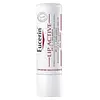What's inside
What's inside
 Key Ingredients
Key Ingredients

 Benefits
Benefits

 Concerns
Concerns

 Ingredients Side-by-side
Ingredients Side-by-side

Prunus Amygdalus Dulcis Oil
Skin ConditioningGlycerin
HumectantRicinus Communis Seed Oil
MaskingCocos Nucifera Oil
MaskingWater
Skin ConditioningBehenyl Behenate
EmollientButyrospermum Parkii Butter
Skin ConditioningHelianthus Annuus Seed Cera
EmollientDiisostearoyl Polyglyceryl-3 Dimer Dilinoleate
EmollientSodium Hyaluronate
HumectantCentella Asiatica Extract
CleansingMenthol
MaskingTocopherol
AntioxidantAscorbyl Palmitate
AntioxidantCopernicia Cerifera Cera
EmollientHelianthus Annuus Seed Oil
EmollientPolyglyceryl-4 Diisostearate/Polyhydroxystearate/Sebacate
EmulsifyingCitronellol
PerfumingGeraniol
PerfumingAroma
CI 15850
Cosmetic ColorantCI 77491
Cosmetic ColorantPrunus Amygdalus Dulcis Oil, Glycerin, Ricinus Communis Seed Oil, Cocos Nucifera Oil, Water, Behenyl Behenate, Butyrospermum Parkii Butter, Helianthus Annuus Seed Cera, Diisostearoyl Polyglyceryl-3 Dimer Dilinoleate, Sodium Hyaluronate, Centella Asiatica Extract, Menthol, Tocopherol, Ascorbyl Palmitate, Copernicia Cerifera Cera, Helianthus Annuus Seed Oil, Polyglyceryl-4 Diisostearate/Polyhydroxystearate/Sebacate, Citronellol, Geraniol, Aroma, CI 15850, CI 77491
Cera Microcristallina
Emulsion StabilisingOctyldodecanol
EmollientHydrogenated Polydecene
EmollientRicinus Communis Seed Oil
MaskingCetyl Palmitate
EmollientPolyglyceryl-3 Diisostearate
EmulsifyingPanthenol
Skin ConditioningEthylhexyl Triazone
UV AbsorberButyl Methoxydibenzoylmethane
UV AbsorberCetearyl Alcohol
EmollientBis-Diglyceryl Polyacyladipate-2
EmollientMyristyl Myristate
EmollientC20-40 Alkyl Stearate
Skin ConditioningGlycerin
HumectantCopernicia Cerifera Cera
EmollientWater
Skin ConditioningTocopheryl Acetate
AntioxidantSimmondsia Chinensis Seed Oil
EmollientButyrospermum Parkii Butter
Skin ConditioningBisabolol
MaskingCera Alba
EmollientCera Microcristallina, Octyldodecanol, Hydrogenated Polydecene, Ricinus Communis Seed Oil, Cetyl Palmitate, Polyglyceryl-3 Diisostearate, Panthenol, Ethylhexyl Triazone, Butyl Methoxydibenzoylmethane, Cetearyl Alcohol, Bis-Diglyceryl Polyacyladipate-2, Myristyl Myristate, C20-40 Alkyl Stearate, Glycerin, Copernicia Cerifera Cera, Water, Tocopheryl Acetate, Simmondsia Chinensis Seed Oil, Butyrospermum Parkii Butter, Bisabolol, Cera Alba
Ingredients Explained
These ingredients are found in both products.
Ingredients higher up in an ingredient list are typically present in a larger amount.
This ingredient is also known as shea butter. It is an effective skin hydrator and emollient.
Emollients help soothe and soften your skin. It does this by creating a protective film on your skin. This barrier helps trap moisture and keeps your skin hydrated. Emollients may be effective at treating dry or itchy skin.
Shea butter is rich in antioxidants. Antioxidants help fight free-radicals, or molecules that may harm the body. It is also full of fatty acids including stearic acid and linoleic acid. These acids help replenish the skin and keep skin moisturized.
While Shea Butter has an SPF rating of about 3-4, it is not a sunscreen replacement.
Shea butter may not be fungal acne safe. We recommend speaking with a professional if you have any concerns.
Learn more about Butyrospermum Parkii ButterThis ingredient comes from a palm tree native to Brazil. This ingredient is used to thicken texture and leaves behind a film when applied.
Glycerin is already naturally found in your skin. It helps moisturize and protect your skin.
A study from 2016 found glycerin to be more effective as a humectant than AHAs and hyaluronic acid.
As a humectant, it helps the skin stay hydrated by pulling moisture to your skin. The low molecular weight of glycerin allows it to pull moisture into the deeper layers of your skin.
Hydrated skin improves your skin barrier; Your skin barrier helps protect against irritants and bacteria.
Glycerin has also been found to have antimicrobial and antiviral properties. Due to these properties, glycerin is often used in wound and burn treatments.
In cosmetics, glycerin is usually derived from plants such as soybean or palm. However, it can also be sourced from animals, such as tallow or animal fat.
This ingredient is organic, colorless, odorless, and non-toxic.
Glycerin is the name for this ingredient in American English. British English uses Glycerol/Glycerine.
Learn more about GlycerinRicinus Communis Seed Oil is the INCI name for castor oil.
Castor Oil helps moisturize the skin. It is rich in a fatty acid called ricinoleic acid. This fatty acid helps prevent moisture loss on the skin. This helps keep your skin soft and hydrated. Ricinoleic acid also has anti-inflammatory and pain reducing properties.
Besides hydrating the skin, castor oil is also used to hydrate hair. By keeping the hair shaft moisturized, breakage is decreased. More studies are needed to show castor oil's effective on stimulating hair growth.
Castor oil is created by cold-pressing castor seeds and then purifying the oil with heat. It was used in Ancient Egypt as fuel in lamps and to help treat eye irritation.
The term 'fragrance' is not regulated in many countries. In many cases, it is up to the brand to define this term. For instance, many brands choose to label themselves as "fragrance-free" because they are not using synthetic fragrances. However, their products may still contain ingredients such as essential oils that are considered a fragrance.
Learn more about Ricinus Communis Seed OilWater. It's the most common cosmetic ingredient of all. You'll usually see it at the top of ingredient lists, meaning that it makes up the largest part of the product.
So why is it so popular? Water most often acts as a solvent - this means that it helps dissolve other ingredients into the formulation.
You'll also recognize water as that liquid we all need to stay alive. If you see this, drink a glass of water. Stay hydrated!
Learn more about Water